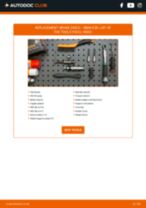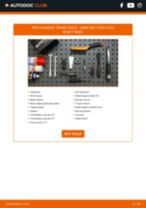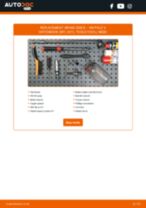Changing Brake Discs yourself – manuals and video tutorials
Changing Brake Discs: step-by-step guides
Most viewed video tutorials on the installation of Brake Discs
 How to change brake discs [AUTODOC TUTORIAL]
How to change brake discs [AUTODOC TUTORIAL] How to change rear brake discs and brake pads MITSUBISHI OUTLANDER 1 TUTORIAL | AUTODOC
How to change rear brake discs and brake pads MITSUBISHI OUTLANDER 1 TUTORIAL | AUTODOC How to change front brake discs and front brake pads on BMW 5 E60 TUTORIAL | AUTODOC
How to change front brake discs and front brake pads on BMW 5 E60 TUTORIAL | AUTODOC How to change rear brake discs and rear brake pads on VW PASSAT CC 1 TUTORIAL | AUTODOC
How to change rear brake discs and rear brake pads on VW PASSAT CC 1 TUTORIAL | AUTODOC How to change front brake discs and brake pads Mitsubishi Outlander 1 TUTORIAL | AUTODOC
How to change front brake discs and brake pads Mitsubishi Outlander 1 TUTORIAL | AUTODOC How to change front brake discs and front brake pads on VW PASSAT CC 1 TUTORIAL | AUTODOC
How to change front brake discs and front brake pads on VW PASSAT CC 1 TUTORIAL | AUTODOC How to change a front brake discs and front brake pads FORD FOCUS 3 TUTORIAL | AUTODOC
How to change a front brake discs and front brake pads FORD FOCUS 3 TUTORIAL | AUTODOC How to change rear brake discs and rear brake pads on TOYOTA COROLLA E120 TUTORIAL | AUTODOC
How to change rear brake discs and rear brake pads on TOYOTA COROLLA E120 TUTORIAL | AUTODOC How to change front brake discs and front brake pads on MERCEDES-BENZ S W221 TUTORIAL | AUTODOC
How to change front brake discs and front brake pads on MERCEDES-BENZ S W221 TUTORIAL | AUTODOC How to change front brake discs and front brake pads on VW PASSAT B5+ TUTORIAL | AUTODOC
How to change front brake discs and front brake pads on VW PASSAT B5+ TUTORIAL | AUTODOC How to change front brake discs and front brake pads on OPEL ASTRA H TUTORIAL | AUTODOC
How to change front brake discs and front brake pads on OPEL ASTRA H TUTORIAL | AUTODOC How to change front brake discs and front brake pads on FORD FOCUS 2 TUTORIAL | AUTODOC
How to change front brake discs and front brake pads on FORD FOCUS 2 TUTORIAL | AUTODOC How to change rear brake discs and brake pads BMW 3 E90 TUTORIAL | AUTODOC
How to change rear brake discs and brake pads BMW 3 E90 TUTORIAL | AUTODOC How to change a rear brake discs and rear brake pads on MERCEDES-BENZ S W220 TUTORIAL | AUTODOC
How to change a rear brake discs and rear brake pads on MERCEDES-BENZ S W220 TUTORIAL | AUTODOC How to change front brake discs and front brake pads on HONDA JAZZ 1 TUTORIAL | AUTODOC
How to change front brake discs and front brake pads on HONDA JAZZ 1 TUTORIAL | AUTODOC How to change rear brake discs and rear brake pads on BMW 5 E60 TUTORIAL | AUTODOC
How to change rear brake discs and rear brake pads on BMW 5 E60 TUTORIAL | AUTODOC
Replacing Brake Discs: TOP manuals for changing
Video instructions for changing the Brake Discs – playlist by AUTODOC CLUB
 How to change brake discs tutorial | Step-by-step video guide
How to change brake discs tutorial | Step-by-step video guide
Advices on car maintenance
 4 Signs of Brake Disc Wear | AUTODOC
4 Signs of Brake Disc Wear | AUTODOC When to replace your brake pads and discs | AUTODOC
When to replace your brake pads and discs | AUTODOC Top 5 brake repair mistakes | AUTODOC tips
Top 5 brake repair mistakes | AUTODOC tips Brake discs overheating: why it happens and how to fix it | AUTODOC's tips
Brake discs overheating: why it happens and how to fix it | AUTODOC's tips
Unlock your car maintenance assistant!
Track expenses, manage logs, schedule replacements, and more.
How to change Brake Discs on your car yourself
Frequently asked questions about replacing brake discs
Other car repair tutorials

Time to replace parts? Get even better deals in our Shop app.

SCAN ME















 Play all playlists
Play all playlists






























































